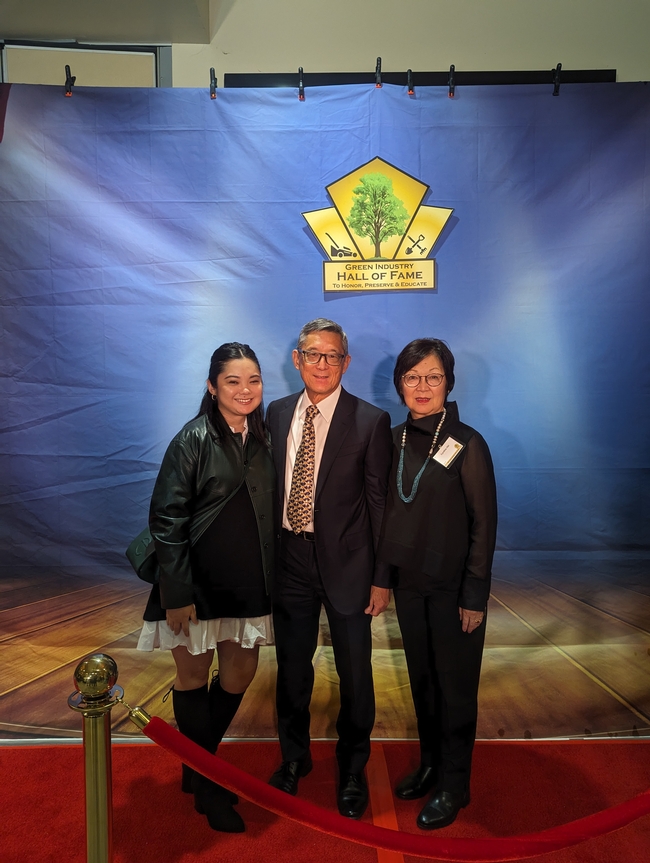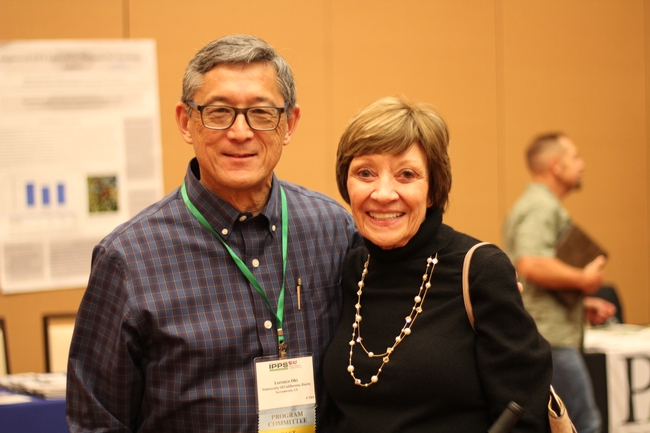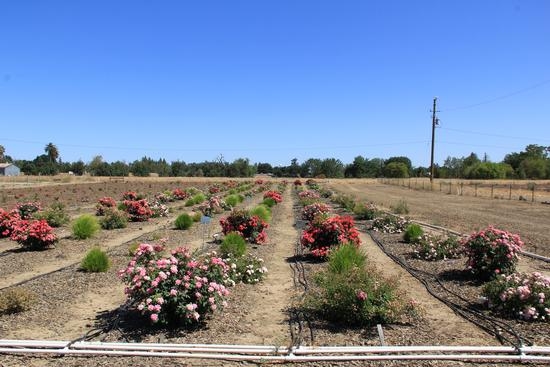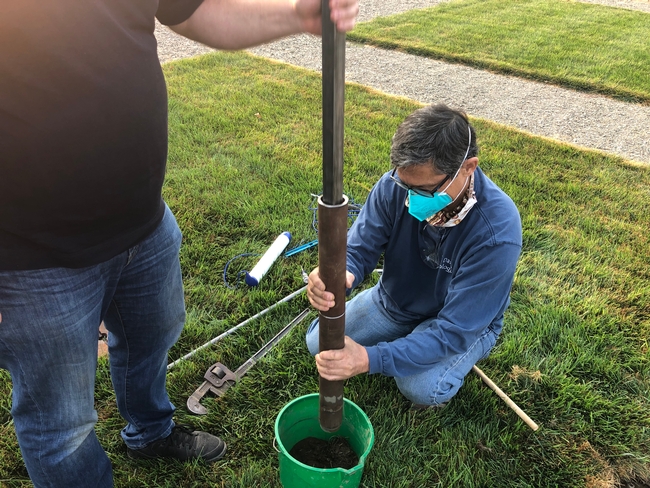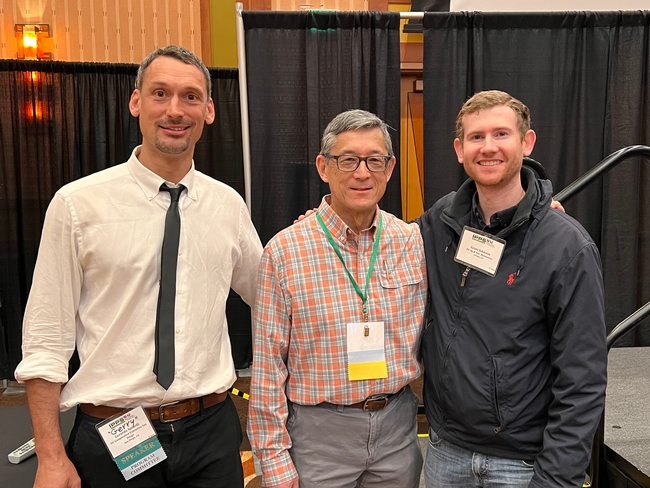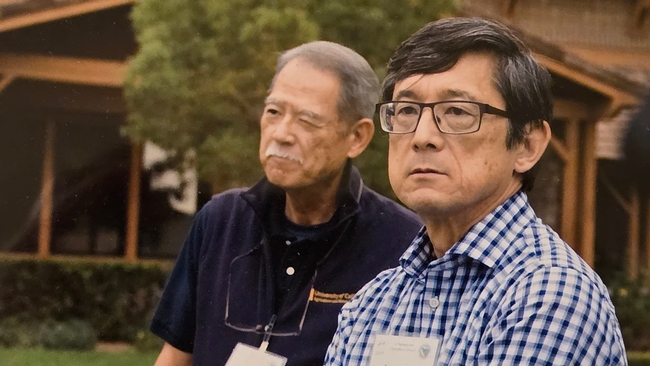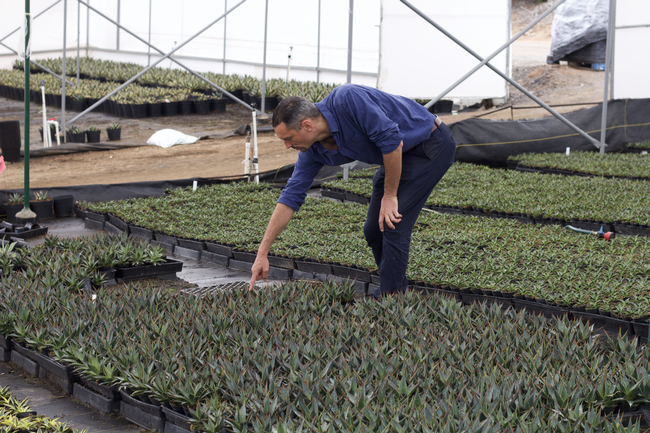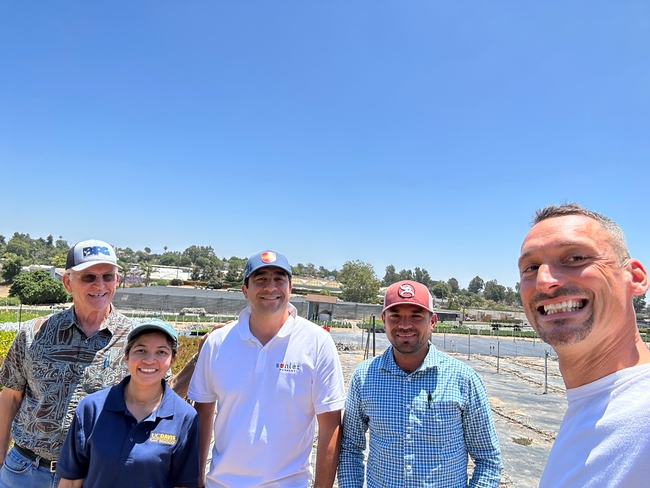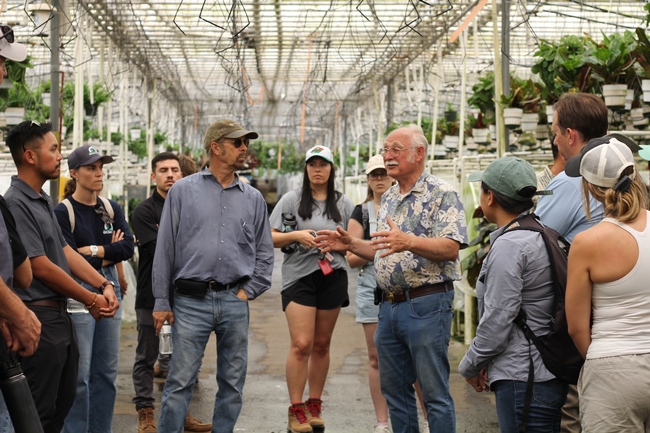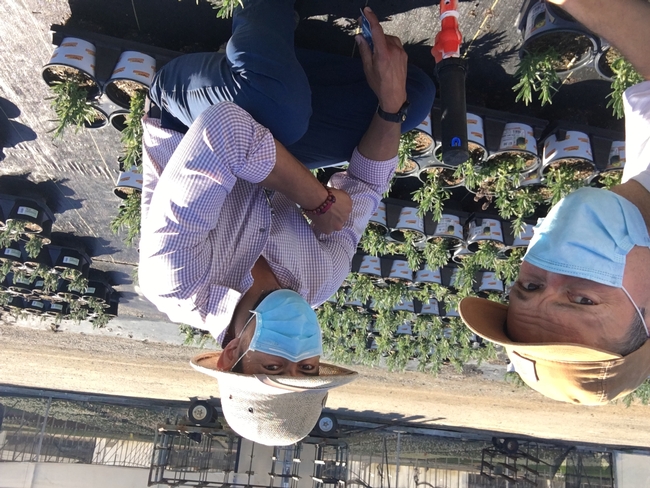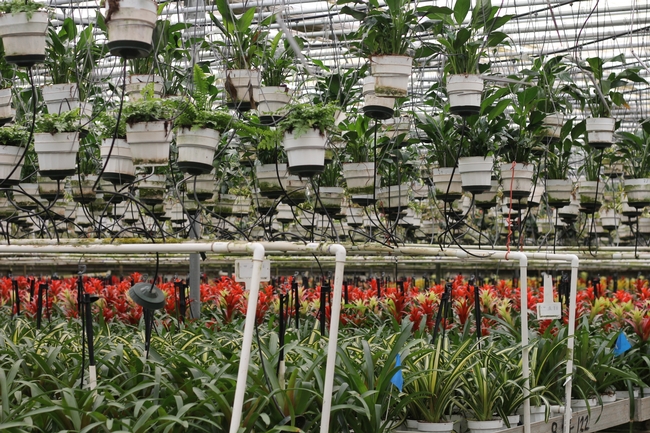Posts Tagged: nursery
Green Hall of Famer Oki retires after 29-year UC career
UCCE specialist's research prevents water pollution, reduces water use
When interviewed to become a University of California Cooperative Extension specialist in environmental horticulture, Lorence “Loren” Oki was asked what kind of research he wanted to conduct.
In response, he showed the hiring committee a photo of a residential gutter. “Water is a big concern, and I found very little research on runoff from homes,” said Oki, explaining that studying residential runoff is what “started his career” with UC Agriculture and Natural Resources back in 2002.
Although he remains active supporting growers and advising industry leaders, Oki retired from UC ANR in July 2023. Before joining ANR, Oki worked as a researcher for UC Davis' Department of Environmental Horticulture studying greenhouse irrigation in 1994, bringing his total time with the University of California to 29 years.
Oki, professor emeritus of Cooperative Extension at UC Davis, led many research projects that advanced the green industry which includes landscapes, nurseries and floriculture.
“Loren is the epitome of a specialist,” said Darren Haver, UC ANR's Research and Extension Center system director, who has worked with Oki for more than 20 years on projects that have significantly improved urban water quality and water conservation efforts across California.
Research influences pesticide management statewide
With a $3 million grant funding a statewide study, Oki and Haver set out to characterize runoff from residential sources over a five-year period. They determined the volume of irrigation runoff from residential land use, as well as the pollutants in the runoff.
Oki and Haver, co-principal investigators, along with researchers from UC Davis and UC Riverside, discovered that the degradation products of the insecticide fipronil – commonly found in runoff water – were more toxic than its parent compound. The study led to an investigation of human pathogens and pathogen indicators in residential runoff, the first of its kind.
Another contribution was the early detection of a new pesticide used for ant control, enabling strategies to be put in place to prevent it from reaching local streams and creeks. Oki and Haver's work also persuaded the California Department of Pesticide Regulation to change pesticide labels to minimize the chances of pesticides moving off target during irrigation and rain events.
These changes included preventing pesticide application before predicted rain and preventing irrigation after applications, keeping pesticides from impervious surfaces, and restricting applications on lawns and landscape beds within two feet of impervious surfaces and others.
Plant trials expand beyond California
Oki was also the principal investigator of the Climate-Ready Landscape Plants project, which may be the largest irrigation trial in the western U.S., and the UC Plant Landscape Irrigation Trials, the California component of that project. The UCPLIT trials originated in 2004 at UC Davis as a research project by Karrie Reid, retired UCCE environmental horticulture advisor for San Joaquin County, while she was pursuing her master's degree. In 2017, the irrigation trials were duplicated at the South Coast Research and Extension Center.
These projects evaluate landscape plants under varying irrigation levels to determine their optimal performance in regions requiring supplemental summer water. Throughout the trial, Oki identified many landscape plants, including rose cultivars, that remain aesthetically pleasing with little water.
Today, the trials have expanded beyond California as the Climate-Ready Landscape Plants Project at Oregon State University, University of Washington, University of Arizona and Utah State University.
Growing up in the nursery industry
In 2017, Oki obtained tenure, allowing him to expand his professional responsibilities to include production horticulture, specifically greenhouses and nurseries, an industry he was extremely familiar with. “I come from a nursery family,” Oki explained. “My grandfather started Oki Nursery in the early 1900s.”
During World War II, Oki's family was incarcerated in the Poston Relocation Center in Arizona and lost their homes and property. When they were released, they returned to the nursery industry to rebuild their lives. “After World War II, my father and uncle got more involved with my grandfather's work,” he said.
The Oki family played an instrumental role in technological development for nurseries in general. Oki Nursery, which was located in Sacramento, worked closely with IBM and was the first to use a computerized system in the industry.
Oki developed computerized scheduling for the bedding plants, poinsettias, chrysanthemums, bulbs and other crops. He developed a method to calculate the cost of any crop grown by the nursery at any point in the crop cycle and computerized greenhouse environmental and irrigation controls. This may not sound impressive now, but that was in the 1980s.
“My father was known for being progressive and he also knew everyone at UC Davis,” said Oki. “He wanted to work with anyone who had an interest in doing something good for nurseries.”
Inducted into Green Industry Hall of Fame
In the 1950s, Oki Nursery partnered with researchers from UC Davis' agricultural engineering program and developed the overhead sprinklers commonly used in nurseries today. Until the 1980s, Oki Nursery was the largest nursery in Northern California. Before it shut down in 1993, Oki worked in the family business as a greenhouse manager when runoff became a growing concern.
“I remember getting served with a notice by the Regional Water Quality Control Board stating that we needed to prevent runoff because it was polluted with nitrate fertilizer, which was common in the nursery industry,” Oki said.
One of those efforts focused on using controlled-release fertilizer instead of applying fertilizer via irrigation as a liquid feed. “What we learned is that if we converted nurseries to controlled-release fertilizer, we could reduce the nitrate runoff,” he said. While a member of the Oki Lab, Bruno Pitton earned his Ph.D. studying nursery hydrology and the fate of nitrogen fertilizers in container crop production adding to the information on runoff and nitrate management. Pitton is now the environmental horticulture advisor for Placer and Nevada counties.
In 2023, Oki was inducted into the Green Industry Hall of Fame, which recognizes individuals with a minimum of 20 years in the landscape, nursery or floriculture industry and who have made significant contributions to the field.
Having grown up in the industry, Oki said that his father taught him to never be afraid to try new things. “If you think you have an idea that might work, do the best you can to make it work. If it doesn't work out, then it doesn't work out. And that's OK,” he said.
Revitalizing space for greater impact
This mentality encouraged Oki whenever tackling new tasks, like rebranding the California Ornamental Research Federation, a space for education and collaboration, as UC Nursery and Floriculture Alliance.
In 2009, Oki and David Fujino, executive director of the California Center for Urban Horticulture, became co-directors of CORF, which catered to the cut flower industry. At that time, Oki and Fujino realized that nurseries generated much greater revenue in the state than cut flowers.
“It was a strategic decision to change CORF to UCNFA, which included floriculture and nurseries in the name,” Fujino said. Combined, nurseries and floriculture have consistently placed in the top five agricultural commodities in the state.
When reflecting on their partnership, Fujino said that working with Oki was a “natural fit.” “I couldn't have asked for a better partner, a better colleague and, ultimately, a better friend to have my back and work side by side,” he added.
Since UCNFA's launch, the two have worked to maintain the group's impact by hosting “Ask your Advisor” webinars to connect advisors to growers, as well as co-hosting large-scale events such as the annual conference for the International Plant Propagators' Society — an organization focused on greenhouse and nursery production education — for the Western Region, which Oki's father helped establish in the 1960s.
Encouraging a return to education
Gerry Spinelli, UC Cooperative Extension production horticulture advisor for San Diego County and member of UCNFA's administrative committee, described those who have learned from Oki as his sons and daughters. “When I meet someone that's learned from Loren or worked with him, that person instantly becomes my friend. That's the kind of effect Loren has on us,” Spinelli said.
Grant Johnson, UC Cooperative Extension urban agricultural technology advisor for Los Angeles and Orange counties, credits Oki for his master's degree in horticulture from UC Davis.
“Loren gave me a lot of direction as far as career choices and research interests. He instilled in me a dedication to life-long learning, just like he continues to do,” said Johnson. Before Oki became his professor, Johnson worked with Oki as a staff research associate at the South Coast Research and Extension Center in Irvine.
Another influential person in Oki's life is John Kabashima, emeritus environmental horticulture advisor for UCCE Orange and Los Angeles counties and fellow Green Hall of Fame inductee. Like Oki, Kabashima grew up in the nursery industry.
Oki, who earned a bachelor's degree in ornamental horticulture from Cal Poly San Luis Obispo and a master's degree in plant science from UC Riverside, decided to pursue a Ph.D. in ecology at UC Davis with Kabashima's encouragement.
While Oki was still working in his family's business, Kabashima said that Oki relied on UC ANR researchers for scientific information and felt like Oki wanted to be one of them. “I told him that he's a good nursery guy, but he's a better scientist,” said Kabashima. “His heart is in science.”
The two began working together as soon as Oki became a graduate student and have been colleagues and friends for nearly 40 years. “My favorite response from Loren whenever people ask him a question is, ‘It depends,'” Kabashima said. “It always leads to people opening up and giving more context. That's what Loren does, he gets you to think.”
UCCE San Diego advisor educates growers on complex water regulations
‘Ag Order' for San Diego County expected to be enforced by end of 2023
Generally known for its steady warmth and picturesque beaches, San Diego County is also home to nearly 5,000 small farms and is an economic hotspot for nurseries and floriculture. But the great diversity of ornamental crops that dominate the growing region and complexity of regulations make compliance challenging for growers, some of whom grow over 400 crop varieties.
“The regulatory environment for the growers is still complicated and overwhelming because, along with the Regional Water Board, growers are regulated by the County of San Diego,” said Gerardo “Gerry” Spinelli, University of California Cooperative Extension production horticulture advisor for San Diego County.
To help growers with compliance, Spinelli is prioritizing education and expanding growers' knowledge. By partnering with organizations such as the Farm Bureau of San Diego County and the San Diego Region Irrigated Lands Group, Spinelli works to reach more than 1,200 growers, supporting them as they navigate regulatory agencies.
Formally referred to as the Regional Water Quality Control Boards, the Regional Water Board aims to develop and enforce water quality objectives and implement plans to protect the beneficial uses of California's waters.
A unique place to grow in California
About 10 years ago, the Regional Water Board created the Agricultural Order (Ag Order), a set of rules outlining how growers manage water discharge from agricultural operations.
The new Ag Order for San Diego County, expected to be enforced by the end of 2023, will focus on nitrogen management and groundwater quality. However, new considerations are needed to address the variety of crops grown by a single farmer, a common practice in San Diego.
Calculating nitrogen input and output for more than 400 crop varieties is not feasible for small farmers, a challenge exacerbated by the meticulous attention needed for San Diego's high-end specialty crops like ornamentals, native plants and specialty fruit.
Furthermore, many San Diego growers have limited expertise and experience because they are entering agriculture as a second or third career. Many have become “accidental growers” in that they purchased land with a preexisting avocado or cherimoya grove, for example.
To help address these challenges, the grower community is emphasizing the need for more educational opportunities that are accessible and relatable.
Equipping growers through education
Enrico Ferro, president of the San Diego Region Irrigated Lands Group – a third-party entity that manages water sample testing on behalf of growers – has relied on Spinelli's teaching to “bridge the gap” for growers, including himself.
“Gerry has been great because he has expertise in nurseries, but the educational content he creates is relevant to all growers,” said Ferro, who is an avocado and citrus grower in San Diego's North County.
Spinelli, who specializes in containerized production in nurseries and floriculture, has been instrumental in providing technical assistance to growers since he joined Cooperative Extension in 2020.
“I started teaching over Zoom since I became an advisor during the pandemic, and I try to cover different topics for each training,” Spinelli said, adding that he teaches in English and Spanish, making his content more accessible to the grower community in San Diego.
For in-person educational opportunities, Spinelli created the “Last Wednesday” monthly meetings hosted at the Farm Bureau of San Diego County, which brings together growers and other agricultural experts to learn from one another.
“We try to get our information out in creative ways and Gerry is instrumental in that. He's our primary source of really wonderful information delivered in an engaging way,” said Tasha Ardalan, program coordinator for the SDRILG. “He's proactive and is always willing to try new things, too.”
Planning for San Diego's agricultural future
Currently, the Ag Order is modeled around regulations for the Central Valley. As conversations and planning for San Diego County continue, Spinelli is supporting the Regional Water Board with information on nurseries and greenhouses in hopes that the final Ag Order will better serve San Diego growers.
“I'm trying to help others understand how nursery and greenhouse production systems function, and how and why they are different from an almond orchard or tomato field in Fresno,” explained Spinelli.
Michael Mellano, CEO of Mellano & Company, a fresh cut flower grower and distributor in Oceanside, feels the impact of the Ag Order and its failure to account for variability. Growing over 100 varieties of flowers, Mellano said that for several plants there is little scientific research on how much nitrate to apply.
“Farmers want to do a good job. We make mistakes and we try to fix them as quickly as we can, and we try to educate others on what works,” said Mellano, who is also a member of the SDRILG.
Growers like Mellano and Ferro agree that the farming community in San Diego needs to be given the latitude to solve problems within their means, an ability that requires an understanding of San Diego's uniqueness.
“San Diego is significantly different, and we need an Ag Order that is reflective of our differences,” said Valerie Mellano, SDRILG consultant and former UCCE environmental issues farm advisor. “In developing the new Ag Order, there's a huge opportunity for education and research, something that we know Gerry can easily do and continue to support us in.”
Thus far, Spinelli's educational content has reached two-thirds of SDRILG's 1,200 members. In addition to the live training sessions, growers can watch videos that cover topics such as evapotranspiration, irrigation distribution uniformity, water quality indicators and more on Spinelli's YouTube channel.
Since the Ag Order requires all growers to complete two hours of water-quality education, the SDRILG has agreed to apply one hour of credit to growers who attend a one-on-one session with Spinelli.
As San Diego's growers continue to leverage educational opportunities – whether it's alongside Spinelli, SDRILG or learning from one another – Spinelli emphasized that their success also relies on an ag order that adheres to a distinctive landscape, multitude of specialty crops and growers with varying expertise.
UC Davis Arboretum Teaching Nursery's Online Plant Sales Scheduled
If you've been thinking about bees, butterflies and other pollinators--and wondering when the next UC Davis Arboretum Teaching...
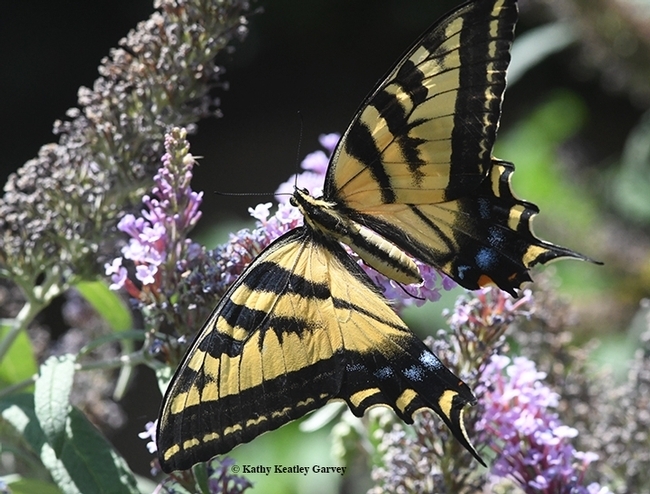
A Western tiger swallowtail, Papilio rutulus, nectaring on a butterfly bush, Buddleia davidii. Many nectar plants will be available at the UC Davis Arboretum Nursery online plant sales. (Photo by Kathy Keatley Garvey)
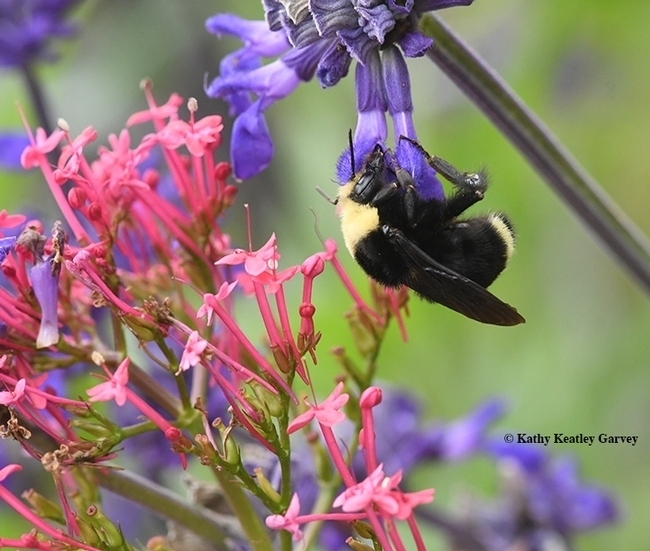
A yellow-faced bumble bee, Bombus vosnesenskii, nectaring on a purple salvia, Salvia farinacea. Salvias are popular in pollinator gardens.(Photo by Kathy Keatley Garvey)
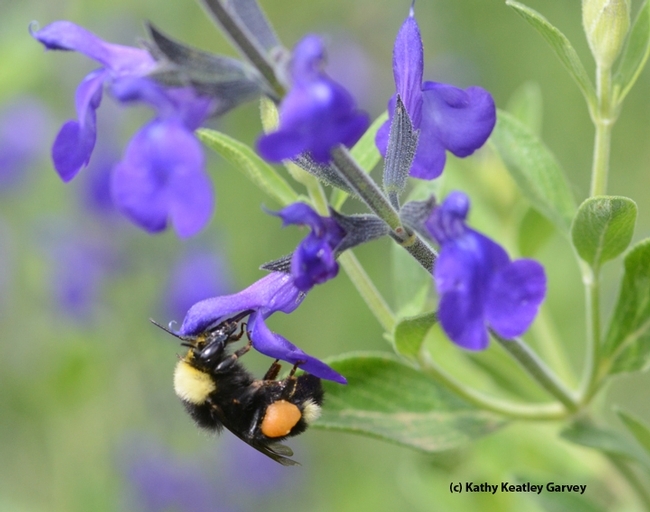
A black-faced bumble bee, Bombus californicus, foraging on purple ginny salvia. Salvias are popular at the UC Davis Arboretum nursery plant sales. (Photo by Kathy Keatley Garvey)
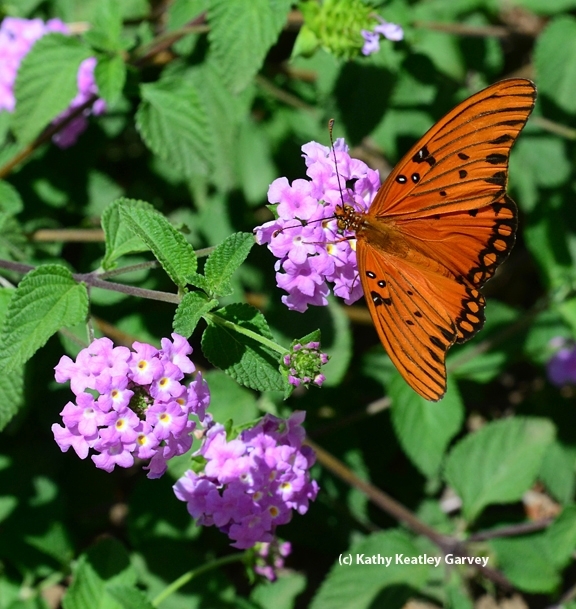
A Gulf Fritillary, Agraulis vanillae, on purple lantana. (Photo by Kathy Keatley Garvey)
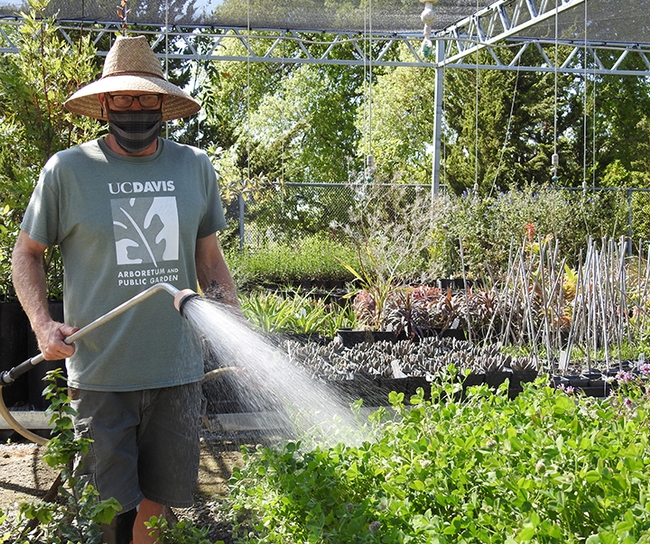
UC Davis Arboretum Teaching Nursery manager Taylor Lewis caring for the plants. Plant sales this year are online sales with curbside pickup. (Photo by Kathy Keatley Garvey)
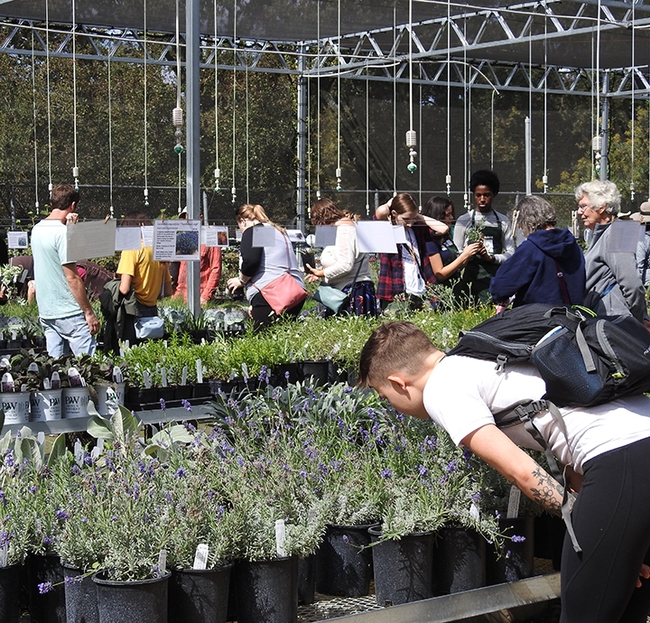
COVID-10 pandemic precautions have changed the in-person plant sales to online plant sales at the UC Davis Arboretum Teaching Nursery. (Photo by Kathy Keatley Garvey)
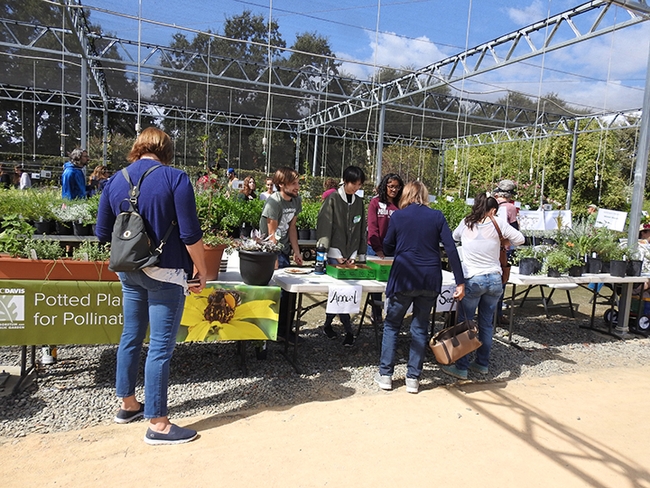
This is a scene from the pre-COVID-19 UC Davis Arboretum Teaching Nursery plant sales. The sales are now online, with curbside pickup. (Photo by Kathy Keatley Garvey)
UC Davis Plant Sale May 20-24: Just Add Pollinators
If you want to draw pollinators to your yard, think of the plants for sale at the teaching nursery maintained by the UC Davis Arboretum and...
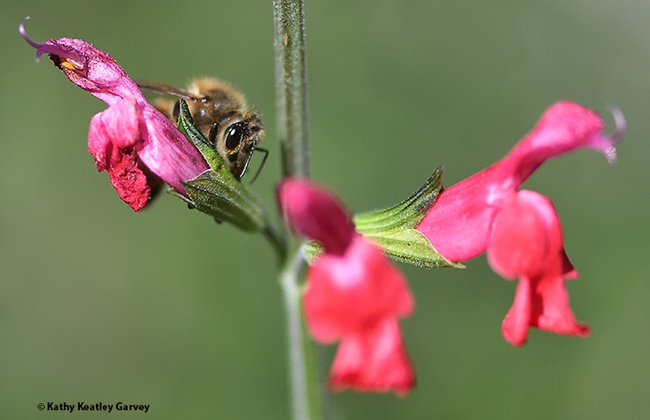
A honey bee foraging on Salvia "Hot Lips." (Photo by Kathy Keatley Garvey)
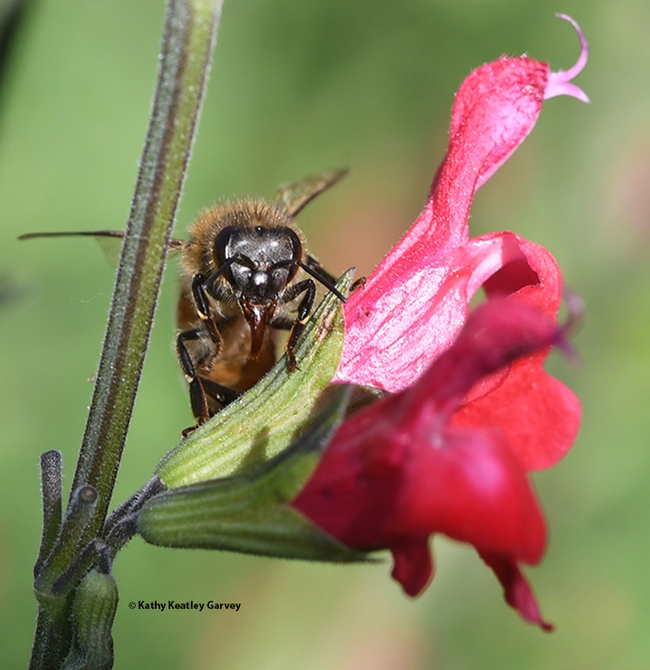
A honey bee, proboscis (tongue) extended, takes a liking to the Salvia "Hot Lips." (Photo by Kathy Keatley Garvey)

The honey bee checks out the photographer. (Photo by Kathy Keatley Garvey)
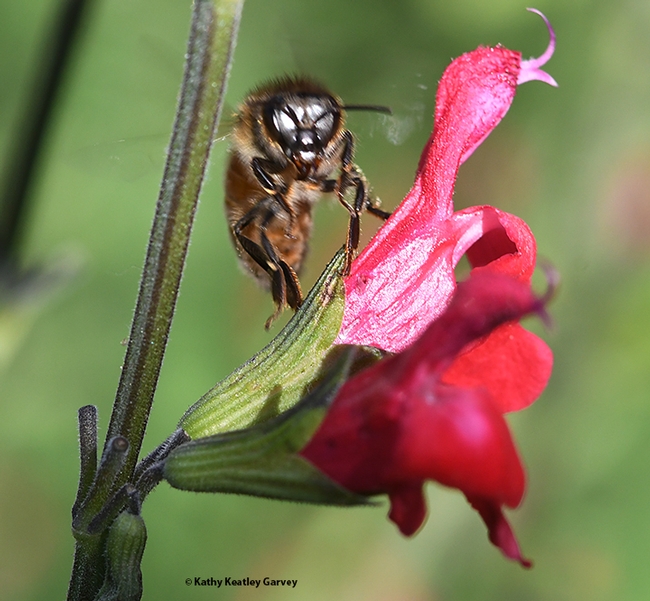
Flight time! The honey bee prepares to leave Salvia "Hot Lips." (Photo by Kathy Keatley Garvey)
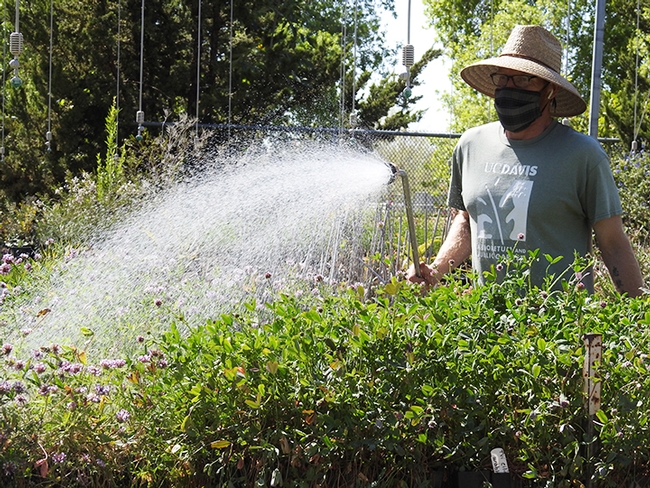
Nursery manager Taylor Lewis of the Arboretum Teaching Nursery, UC Davis Arboretum and Public Garden, tends to plants in the nursery. An online public sale is set May 20-24. (Photo by Kathy Keatley Garvey)
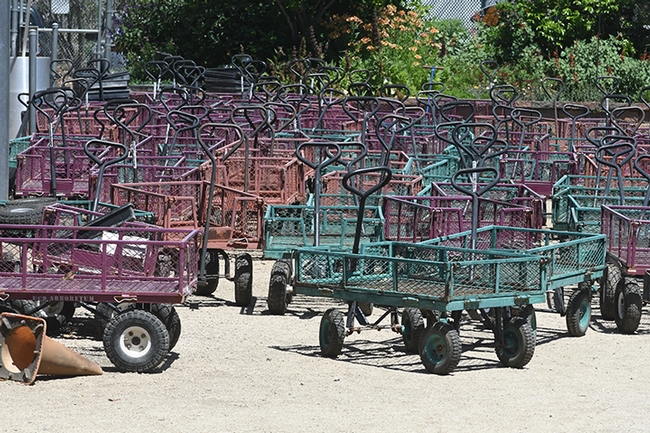
These carts will be in use with the UC Davis Arboretum's online plant sales take place May 20-24. Delivery is curbside.(Photo by Kathy Keatley Garvey)
Magical, Miraculous Monarch Moments
When you observe a monarch butterfly laying eggs on your milkweed--and see the predators and parasitoids circling in anticipation--act fast if...
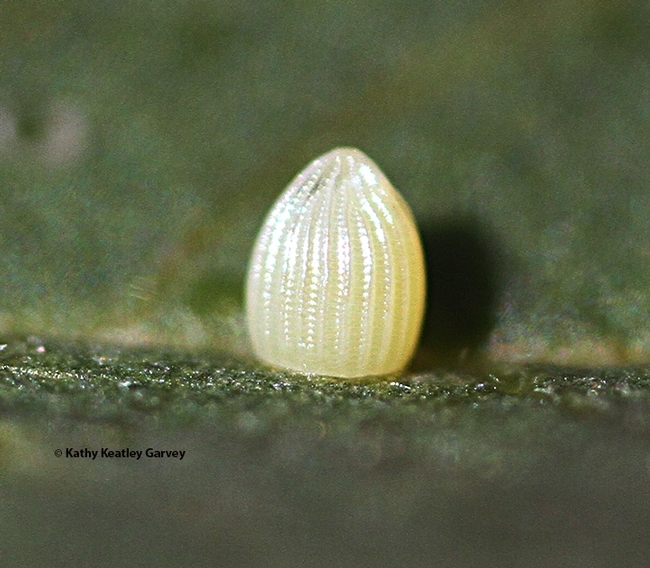
A monarch egg. Soon it will hatch. (Photo by Kathy Keatley Garvey)
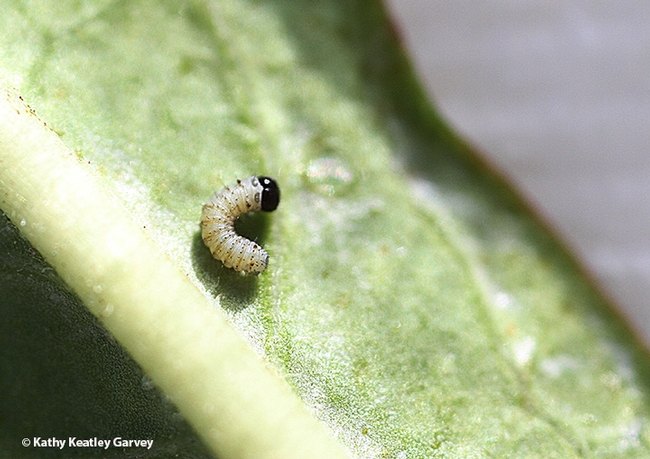
This larva or caterpillar has just hatched. Note the black head. (Photo by Kathy Keatley Garvey)
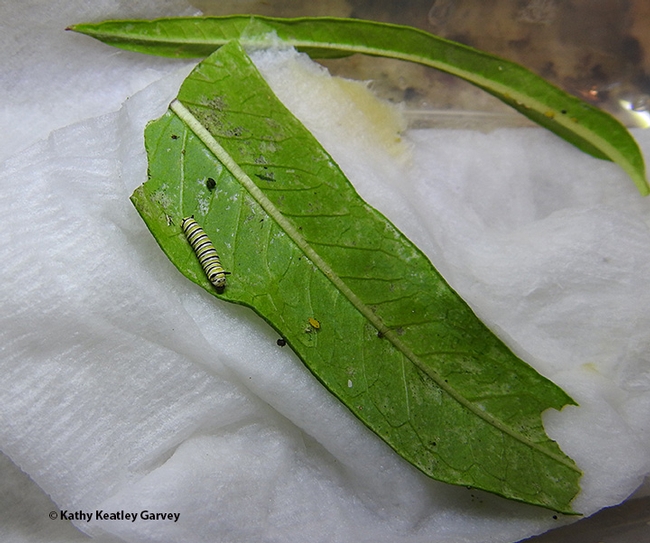
Growing, growing, growing. Now all the caterpillar has to do is eat, eat, eat. (Photo by Kathy Keatley Garvey)
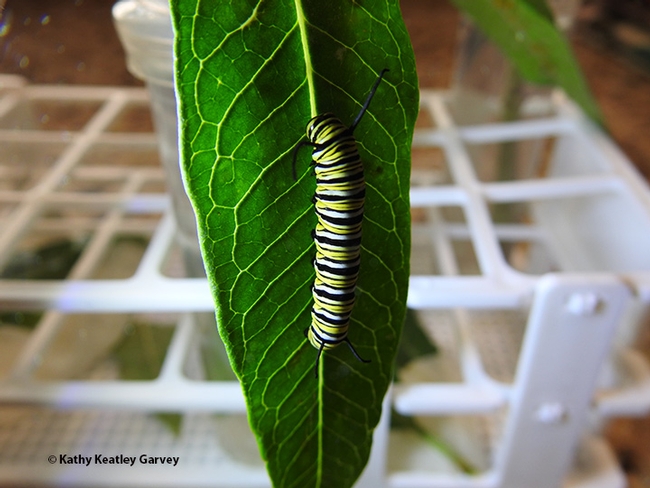
This third instar caterpillar rests on a leaf in its new environment. It was just removed from a lidded container--lidded to keep the milkweed leaf damp. Otherwise, it will dry out. (Photo by Kathy Keatley Garvey)
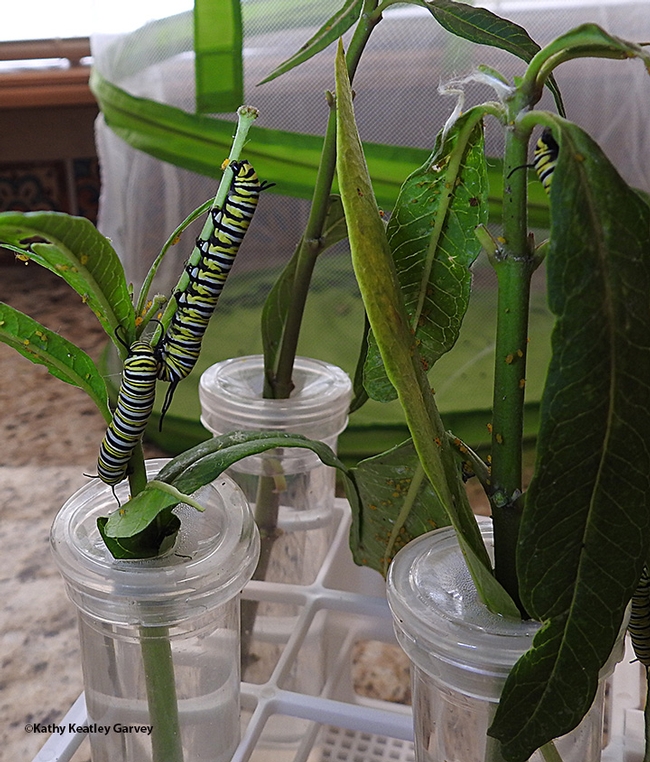
Three monarch caterpillars munching away on milkweed. Two of the 'cats just encountered one another. (Photo by Kathy Keatley Garvey)


